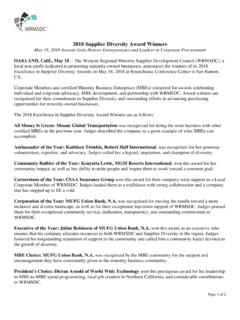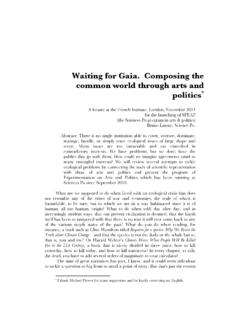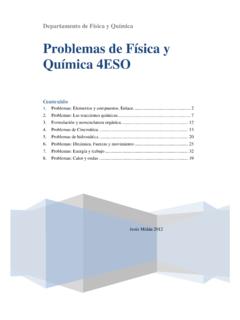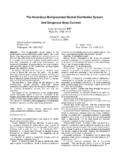Transcription of Basic Globalization Types - Bruno G. Rüttimann
1 Modeling Economic Globalization : The Basic Globalization Types Bruno G. Ruettimann Abstract Present economics theory is not giving sufficient practical models to explain recent economic development regarding Globalization . Indeed, Globalization is not always the same Globalization , as it is recognized through the different manifestations of this phenomenon. Based on the four Basic business typologies (commodities, standards, specialties, convenience goods) a new model defines five fundamental Types of economic Globalization (named 1a, 1b, 1c, 2, and 3). Globalization type 1 is related to physical material interchange, type 2 is related to financial participations and type 3 is related to the human factor. This distinction is necessary because each one has its own rational and performs differently from a Globalization viewpoint. These Basic Globalization Types help to model the triggering mechanism of their evolution and allow us to understanding the competitive constellation and strategic moves of companies as well as the different latent potential for unemployment.
2 (Key words: Business Types , Globalization Types , Foreign Trade Theory). Introduction Globalization on the one hand is often seen as an obscure process that apparently yields more profit for the companies, while increasing unemployment for the working classes on the other hand. Globalization is hardly controllable, since it is not only a process but rather the phenotypical manifestation within the causal systemic world of economy and politico-social behaviour. But how can Globalization be modelled? Many books have been written on Globalization but no individual one presents an integrated theory of it. Basic concepts go still mainly back to foreign trade theory with Ricardian comparative cost advantages and Pareto optimality. New models have been developed by Krugman in his New Economic Geography . Different business and Globalization patterns are observable in different industries. On the one hand we have the extraction of raw materials in particular geographic regions of the subtropics or primary aluminium production in distant but low energy cost regions, and on the other hand, semi-fabricated products manufactured near extensively industrialized regions.
3 Cars produced in highly automated factories in urban area and exported worldwide, fast-food chains or franchised fashion stores covering the globe to conquest market share different concepts, but the same target: the world market. Why do so many different concepts exist? What are the rules governing the economic structure and the competitive system? Is it possible to give a structure to Globalization in order to be modelled? The Determinants for Globalization Type Going beyond the usual phenomenological description of Globalization let us analyze the intrinsic logic of worldwide competition and the structure of the economic system. Our business system is mainly composed of: - the transaction object , the product or service - the supply and demand structure, with the related transaction scheme, and - the operating configuration of supply. Bruno G. R ttimann 1. The product is characterized by its attributes, heavy or bulky, complex or precious, perishable or durable, and its customisation degree, all this determining the transportability of the product.
4 The transaction scheme describes how supply and demand interact determining the localization degree of the product. The market structures given by the number of market actors and relative concentration curves of supply and demand determines the competitive nature of the business. The operating configuration refers to how products are produced, at one extreme they are produced centrally within a single plant configuration and then distributed worldwide, or production facilities are spread around different geographic regions within a multi- plant configuration and products are sold locally. This leads to the induction scheme of to classify first the business type and finally the Globalization type. Indeed, globalisation is not always the same globalisation, as we will see. Product Product Market Market characteristics characteristics structure structure Business Business Operating Operating classification classification configuration configuration Typeof Type ofglobalization Globalization Abbildung 1: Framework of Globalization Types determinants From it is evident that the typology of Globalization is largely determined by the product characteristics.
5 The backward determinants themselves which influence product characteristics, market structure, and determine the business classification, and finally the operating configuration, are: - value of the product - transport cost and related range of distribution - production factors in terms of cost drivers - demand profile and - supply structure. The Four Basic Business Typologies These main determinants characterise each business type within an industrial system. Certain combinations of these determinants reveal clear patterns for each business type. shows different businesses within the matrix of product- characteristics and market-structure which are the main drivers for business type classification. The representation of product-characteristics (differentiated or not) as one axis, and market-structure (oligopolistic or fragmented) as another axis within a matrix, leads finally to the following landscape of Basic business Types : - commodities - specialties - standards - convenience.
6 Bruno G. R ttimann 2. differentiated PRODUCT CHARACTERISTICS. Convenience Speciality non differentiated Standards Commodity polypolistic oligopolistic MARKET STRUCTURE. Abbildung 2: Selected businesses within the Abbildung 3: Basic classification of business Types product-characteristic / market-structure matrix presents a clear, systematic and structured view with which to classify roughly the businesses in Types . It goes without saying that mixed Types may exist. The commodity type of business ( primary aluminium or wheat) comprises all kinds of goods listed on efficient market places, such as commodities exchanges with world market prices. The specialty type of business ( electronics or automobile). embraces those durables and consumables goods with a distinctive brand thus creating imperfect competition. The standards type of business ( cement or extrusions) covers the intermediate or semi-finished products with a rather polypolistic supply structure. The convenience type of business ( hotels or clothing) embraces most products of our life sold in retail stores in a very fragmented market to reach the final demand, representing from the supply side an imperfect or monopolistic competition.
7 Differentiated PRODUCT CHARACTERISTICS. Type Ib Type II. non differentiated Type Ia polypolistic oligopolistic MARKET STRUCTURE. Abbildung 4: The natural Types of Globalization Bruno G. R ttimann 3. The Five Economic Globalization Types Having once classified the business, the question is how Globalization is influenced by each business type, or rather how Globalization of the business evolves in each business type and according to which pattern. Analysing the business Types it emerges that the operating configuration determined by the business is a major determinant for the Globalization type. The intrinsic logic reveals two main Types : - type 1 material (or physical) Globalization for commodities and specialties - type 2 immaterial (or financial) Globalization for standards and convenience. The difference is substantial. Products of businesses following type 1 Globalization could be produced finally within a single plant operating configuration and shipped physically worldwide whereas products of businesses following a type 2 Globalization are produced locally for the local market.
8 MNE (Multi National Enterprises) will have in this case a network of local companies by FDI (Foreign Direct Investments) and the business idea is to exploit the know-how in doing business. In this fragmented markets they have to buy or set-up new enterprises to increase market share. But for type 1 Globalization we have to distinguish between commodities and specialties ( ). Let us call type 1a the Globalization of commodities ; through the listing on efficient market places such as commodity exchanges, this represents the pure example of a Globalization of business. Nobody can escape from this type of Globalization because its effects are spreading all over the world. For the type 1b Globalization of specialties the products characteristics are unique and therefore . to some extent - the price can be fixed by the supplier taking into account the value for the customer. This is due to the possibility of product differentiation within the competitive system. For type 2 Globalization the distinction into subtypes is not necessary.
9 Indeed, in markets not accompanied by material (physical) flows of products over a certain distance they, according to Chamberlin, represent a local monopoly. Therefore we need to have no distinction of Globalization patterns between standards and convenience type of products. The localisation of the business leads to a Globalization pattern with a market share adding strategy by FDI. in order to grow in businesses of such Types . support Type III. differentiated PRODUCT CHARACTERISTICS. Type Ib Type II. Type Ic non differentiated Type Ia polypolistic oligopolistic internal MARKET STRUCTURE. Abbildung 5: The Globalization type matrix Bruno G. R ttimann 4. Are there any drivers able to upset this apparently stable situation? Yes, there is one. If the difference in price for the same goods in different economies exceeds a certain threshold, exports can temporarily become possible also for products following type 2. globalisation. We may call this economic arbitrage . In these cases we can observe also a material flow of products within the type 2 globalisation characterised businesses; let us call this type 1c globalisation opportunistic or low cost globalisation.
10 Typical are the exports of low cost countries such as China. Furthermore, if a price difference also exists in different economies for the salaries of white collar jobs and the skills are equivalent - then it is also possible that enterprise functions as R&D, call centres or accounting are outsourced to low cost countries such as India; let us call this type 3 globalisation the globalisation of human factor or service . shows all Types of globalisation within a matrix allowing us to identify roughly the type of globalisation and with that the possible evolution or competitive issues to face within a certain business. The Intrinsic Rational of Each Globalization Type Moreover, these different globalisation Types also follow different economic laws. Type 1a is characterised by global price building and mainly unidirectional material flows from countries of origin to the industrialized countries of transformation ( ). The preference for a raw material compared to another depends from the latent value of a specific resource compared to another substitute resource.





